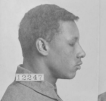Pvt. Richard Brown
Richard Brown was one of the few soldiers in 3/24 Infantry who was from Texas. His date of birth is listed as 1900, making him one of the youngest soldiers in the battalion at the time of the Houston Incident. He quit school after the fourth grade when he was 12 years old. He stated he worked at a bank prior to enlistment, though the bank officials claimed to have no record of his employment. An examination of his case by the Clemency Board in April 1924 stated that he only completed one year of school and had worked as a stable hand. He was arrested in Austin in 1913 as a runaway when he would have been about 13 years old; spent year and a half at the reformatory in Gatesville, TX on that charge. He enlisted into K Co, 24th Infantry, in April 1917, just four months before the Rebellion. He was tried in the first court-martial and did not take the stand in his own defense. He denied any guilt and told the
clemency review board that he was in town on a pass the night of the riot, that he had stayed out of camp after hearing about the trouble, and was at a friend’s house in town until he was arrested the next morning.
A review of his case in March 1919 says that Brown was present at retreat in camp at 1800 hours, and that he was also at the 2000 hours check but absent from the 2130 hours check. He was also absent at reveille the next morning. The report states, “At about 8:00 o’clock on the morning of the 24th, he and two other soldiers were arrested at 1014 Bailey Street, Houston. One of the men was under the house and two in the house. In the house were found five Springfield rifles (one witness testified three) and about 500 rounds of ammunition. The record at the police station showed, ‘August 24, 1917, 9:15 a.m., Richard Brown, negro, 19 [incorrect age], male, soldier, no effects, arrested by soldiers, names unknown.’ He was placed in jail and turned over to the military authorities on the morning of the 25th.”
A clemency request on his case was denied on April 23, 1921. In April 1924 his sentence was remitted to thirty years from life. Brown was paroled on June 14, 1927, and apparently relocated to California. In November 1931, the JAG informed the AG that the Commandant,
Pacific Branch, United States Disciplinary Barracks, Alcatraz, California, had written to recommend that “Brown be released from the provisions of his parole and that the unexecuted portion of his sentence (about five years) be remitted for the following reasons: This man, for the period he has been on parole, has conscientiously complied with all provisions of his parole. His conduct on parole has been excellent. As there is no probability that this man will, in any manner, violate the provisions of his parole after the length of time already served, and be returned for further confinement, it is believed that no good purpose will be served by continuing this man longer on a parole status.” The JAG disagreed, writing, “This office does not concur… It is the opinion of this office that Brown as already been granted considerable clemency and that
further consideration of his case with a view to releasing him from the provisions of his parole and remitting the unexecuted portion of his sentence does not appear warranted.”
In 1936 Brown was back in confinement, this time in the Atlantic Branch, U.S. Disciplinary Barracks. The JAG wrote to the AG: “Brown is serving a sentence of twenty-eight years and six months (reduced from life) for participation in what is known as the ‘Houston Riots.’ He was released on home parole on June 14, 1927… The Commandant reports that
Brown then on home parole violated the terms of his probation on May 19, 1934, and remained absent until June 9, 1936. As a result of such parole violation he has forfeited all good conduct time. The Commandant recommends that clemency be denied. In view of the adverse recommendations of the Board and the Commandant, coupled with the fact that Brown has served only about three months of his sentence to confinement since his return to military control, this office recommends that clemency be denied at this time.” Brown’s parole violation was that he was charged in civilian court with assault with intent to murder and was sentenced to three years in the Texas State Penitentiary. He was transferred to military custody on June 15, 1936.
On August 7, 1940, the JAG recommended that “so much of the remainder of sentence to confinement as exceeds one year be remitted.” The Assistant Secretary of War approved that recommendation on September 5, 1940. [By that date the U.S. was on the verge of entering WWII.] This action stemmed from a report filed by the Board of Psychiatry and Sociology on July 15, 1940: “Considering the length of time prisoner has been in confinement, the value of the
service he has rendered and the fact that his conduct card for the past four years shows no serious infractions of rules it is believed that no constructive benefit will accrue from further incarceration. Maximum clemency is recommended.” The clemency board’s response was to say,
“This prisoner has been in confinement for thirteen years, seven months, and eleven days. During the many years of his confinement, this man has never caused the slightest trouble and his work has been highly satisfactory. His mental attitude toward confinement has been exceptional and he has never committed even a minor infraction against the regulations of the institution. It is believed that the maximum benefits to be obtained from confinement have been obtained.” Based on these recommendations, the JAG approved a remittance of Brown’s sentence to one year, and he was finally released from prison just as America entered into the next world war. He was by then a middle-aged man.

